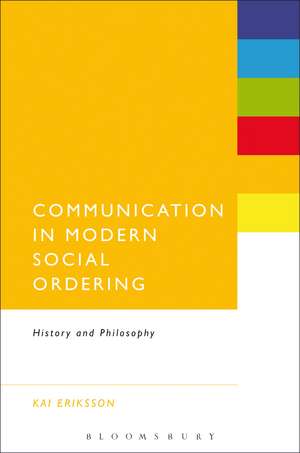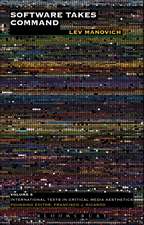Communication in Modern Social Ordering: History and Philosophy
Autor PhD Kai Erikssonen Limba Engleză Paperback – 22 mai 2013
| Toate formatele și edițiile | Preț | Express |
|---|---|---|
| Paperback (1) | 223.93 lei 6-8 săpt. | |
| Bloomsbury Publishing – 22 mai 2013 | 223.93 lei 6-8 săpt. | |
| Hardback (1) | 890.45 lei 6-8 săpt. | |
| Bloomsbury Publishing – 21 sep 2011 | 890.45 lei 6-8 săpt. |
Preț: 223.93 lei
Nou
Puncte Express: 336
Preț estimativ în valută:
42.86€ • 46.57$ • 36.03£
42.86€ • 46.57$ • 36.03£
Carte tipărită la comandă
Livrare economică 22 aprilie-06 mai
Preluare comenzi: 021 569.72.76
Specificații
ISBN-13: 9781623568382
ISBN-10: 1623568382
Pagini: 232
Ilustrații: black & white illustrations
Dimensiuni: 152 x 229 x 12 mm
Greutate: 0.33 kg
Editura: Bloomsbury Publishing
Colecția Bloomsbury Academic
Locul publicării:New York, United States
ISBN-10: 1623568382
Pagini: 232
Ilustrații: black & white illustrations
Dimensiuni: 152 x 229 x 12 mm
Greutate: 0.33 kg
Editura: Bloomsbury Publishing
Colecția Bloomsbury Academic
Locul publicării:New York, United States
Caracteristici
The ontological, history of communication has been largely neglected in the current literature.
Notă biografică
Kai Eriksson, PhD, is a lecturer and research fellow in the Department of Social Research at the University of Helsinki. He is a member of a research project called Electronic Governance and New Forms of Political Power; and recently published an extensive Finnish-language monograph on the ontology of networks and networked politics, Maailma ilman ulkopuolta: Verkostot yhteiskunnallisessa ajattelussa (The World without an Outside: Networks in Social Thought) (Gaudeamus 2009).
Cuprins
Chapter 1: Introduction Chapter 2: Lightning Lines 2.1 - Coming Unity 2.2 - The Nervous System Chapter 3: The Speaking Machine 3.1 - Taylored Systems 3.2 - Machines of Communication Chapter 4: Logical Assemblages 4.1 - Automating Communication 4.2 - Self-Regulating Systems Chapter 5: Communication and ModernityBibliographyIndex
Recenzii
In this wide-ranging and insightful study of the role of communication in modernity, Kai Eriksson continues the grand tradition of critique in the highest and best sense -- that of exploring potentials and tracing limits. What is at stake is not simply a philosophy of communication or an analysis of the technological, economic, and social systems with which it is associated, but, crucially, a study of the forms of community that these thwart and enable. Communication in Model Social Ordering is a formidable and fascinating work of scholarship: an apt demonstration of the sparks of illumination that result from the collision of theory and history.--Mark Andrejevic, Research Fellow at the University of Queensland's Centre for Critical and Cultural Studies
Communication in the Modern Social Ordering traces the "threads" of communicative technologies, social practices, and theoretical treatises as they wind through the United States from the late 19th through the mid-20th centuries. The author highlights the telegraphic "lightning lines" woven like railways across the landscape of America on the verge of modernity. He draws into relief the telephone wires winding under streets and over highways to bind neighborhoods into cities, cities into regions, and both into a nation united by electronically encoded speech. Finally, he reveals the emergence of the computer as the system replacing the telephone exchange as a new center of coordination, command, and control: an intelligence generated by the strategic grammars of corporate and governmental organization. Thus the author traces the outlines of a new social and technological order. Increasingly centralized, rationalized, mathematized, and imagined through the metaphor of the nervous system, communication networks are reformulated in the schematics of the machine and progressively generalized as an oscillation between signal and noise. In the process the theorems of information are inscribed in increasingly lifelike, self-regulating mechanisms. So information theory is revealed here through a discursive history of its embodiments-"a sequence of interrelated but discontinuous formations and constellations of thought and practices," as the author says-in this illuminating (in a way that would please Edison) genealogy of the modern communicative order.--Daniel R. White, Professor of Philosophy, Wilkes Honors College, Florida Atlantic University, author of Postmodern Ecology: Communication, Evolution, and Play
Communication in the Modern Social Ordering traces the "threads" of communicative technologies, social practices, and theoretical treatises as they wind through the United States from the late 19th through the mid-20th centuries. The author highlights the telegraphic "lightning lines" woven like railways across the landscape of America on the verge of modernity. He draws into relief the telephone wires winding under streets and over highways to bind neighborhoods into cities, cities into regions, and both into a nation united by electronically encoded speech. Finally, he reveals the emergence of the computer as the system replacing the telephone exchange as a new center of coordination, command, and control: an intelligence generated by the strategic grammars of corporate and governmental organization. Thus the author traces the outlines of a new social and technological order. Increasingly centralized, rationalized, mathematized, and imagined through the metaphor of the nervous system, communication networks are reformulated in the schematics of the machine and progressively generalized as an oscillation between signal and noise. In the process the theorems of information are inscribed in increasingly lifelike, self-regulating mechanisms. So information theory is revealed here through a discursive history of its embodiments-"a sequence of interrelated but discontinuous formations and constellations of thought and practices," as the author says-in this illuminating (in a way that would please Edison) genealogy of the modern communicative order.--Daniel R. White, Professor of Philosophy, Wilkes Honors College, Florida Atlantic University, author of Postmodern Ecology: Communication, Evolution, and Play














